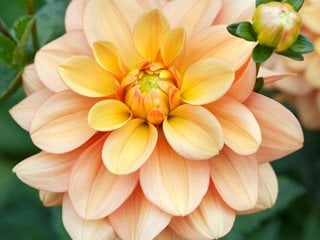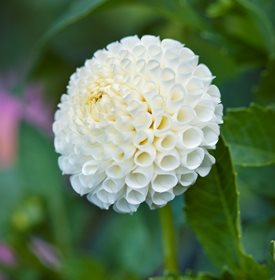How to Grow Dahlia Flowers
Learn how to plant and care for dahlias in your gardenWith their intense color, strength, and ability to keep flowering until the first frosts, dahlias are easy to grow and bring life to your garden. Dahlias like well-balanced and composted soil, and full sun. With 42 different species and thousands of cultivars, dahlias offer plenty of variety. Variations in color, flower form, size, and foliage make it easy to find one you'll love.
On this page: Dahlia Basics | Planting Tips | Care & Storage | Design Ideas | Pictures
DAHLIA BASICS
Zones:
Generally winter hardy in zones 7-10, and tubers can stay in the ground. In colder zones, tubers can be dug up, stored for winter and re-planted in spring, after all danger of frost has passed. (See below for storage tips.)
Height/Spread:
1 to 6 feet tall, and 1 to 3 feet wide depending on the variety; border dahlias range 15 to 20 inches tall.
Exposure:
Full sun
Soil:
Well-balanced, organically rich and well-drained soil.
Water:
Medium
Color:
Varieties include shades of red, pink, lavender, purple, orange, yellow, and white
Bloom Time:
July to September
Dahlia types:
Learn more about the types of dahlias.
PLANTING DAHLIAS
According to Frances Palmer, well-known potter and dahlia enthusiast, a good planting time for tubers is May. Here are her recommendations for planting:
- Place growing cages (tomato cages work well) in the soil and drive in 2-3 stakes adjacent to them for support.
- Dig the hole: For new or single tubers: Place them in a fairly shallow hole, approx. 3 inches deep, with the new bud facing up. For larger groups of tubers: Place in a deeper hole, keeping them approx. 3 inches below the surface. Gently cover with dirt.
- Attach a label to the cage for identification.
- Do not water, as there should be enough moisture in the soil this time of year. Over-watering causes tubers to rot.
- The first leaves should poke through the surface in about 1-2 weeks.
Starting dahlias indoors:
If you live in a cold climate and want to get a head start, tubers can be started inside 6 weeks before moving them out to the garden. Plant them in pots with potting soil and provide plenty of light and water. When the ground temperature in your garden reaches 60°F it is safe to transplant your dahlias.
Planting dahlias in containers:
Low-growing or dwarf dahlias are best for growing in containers. Use a pot with drainage holes and a good quality potting mix. When starting, barely cover the tuber with soil, more can be added as the plant’s stem grows.
Get 7 tips for growing dahlias in pots in this video from Bethany @chicagogardener.
CARE & STORAGE OF TUBERS
Pinching:
When the first set of leaves is about 8 to 12 inches high, pinch out the center bud to encourage multiple stems to grow and produce more flowers. Sometimes this process is called topping.
Fertilizing:
Bone meal can be applied 2 to 3 times between June and October to encourage blooming. If your soil is healthy, this may not be needed at all. Apply an all-purpose fertilizer at planting to get them off to a good start.
Staking:
As your dahlias grow, gently encourage the stems to stay inside the cage for support. Garden twine can be tied around the outside for additional support.
Disbudding:
If you want longer, stronger stems and bigger flowers then you’ll need to remove the two pea-sized buds flanking the central bud. For certain types, it may be beneficial to remove more buds further down the plant. See this disbudding explanation from the Snhomish County Dahlia Society.
Deadheading:
Deadheading will keep your plants looking tidy and encourage them to continue blooming. Many gardeners report that when they regularly deadhead their dahlias, they will bloom until the first frost. Be careful not to remove new buds, which are rounded—the spent flowers have a triangular or cone shape. Make your cut slightly higher than where the stem of the flower meets a main branch. With the spent flower removed, new buds will develop at this intersection and you’ll have more flowers in a few weeks.
Digging and storing tubers:
If you live in an area where you'll need to store your tubers over winter, here are some helpful instructions:
- After the first frost, flowers & stems will immediately wilt. Leave them in the ground for a week or 2 after a few more strong frosts have occurred.
- Pull out support cages and/or stakes.
- Dig outside the circumference of the tubers with a pitchfork. The larger the plant, the larger the tuber; but don’t worry - if tubers are broken apart or damaged during digging, this will not damage the plant.
- Cut off dead stems 2-3 inches above the tuber bunch to give yourself something to hold onto, and gently shake off as much dirt as possible.
- Place a tag on the cut stem for identification.
- Place a few inches of peat moss or wood shavings in the bottom of a large cardboard box.
- Give the tubers a final shake to remove any further dried dirt, and layer them in the box with larger tubers on the bottom. At about half-way full, add another layer of packing material and more tubers. Cover completely with the storage material, shake to settle and top off with more storage material. Fold flaps to close.
- Store in a cool basement or garage that gets to about 40 degrees, but not below freezing.
Pests and Diseases:
Dahlias can be bothered by aphids, stem borers, spider mites, and caterpillars. Additionally, powdery mildew, dahlia mosaic virus and fungal leaf spot can also cause problems.

Magenta ‘Ambition’ and deep-red ‘Nuit d’Eté’ dominate this late-season border; blue Aster x frikartii ‘Mönch’ and gladioli play supporting roles. These late bloomers pick up where summer-flowering plants leave off, giving the garden a grand sendoff for winter. Photo by: Marianne Majerus.
DESIGNING WITH DAHLIAS
There are many ways to use dahlias in the garden. Here are a few tips and suggestions:
- Their lower stems tend to be unattractive and the plants are heavy (especially the large flowered dinnerplate types); so without staking, they tend to flop. Distributing them amongst other plants helps support their weight and also hide their lower stems.
- Taller varieties will grow well with perennials and ornamental grasses toward the rear or center of borders, while shorter dahlias mix well with annuals or shorter perennials.
- Plant the smallest varieties in containers.
- Dahlia flowers are brightly colored, so think about what other flower or foliage colors there are in the landscape, as the dahlias will pick these up and echo them loudly.
- Match with other late-flowering perennials, particularly those with similar color, but different texture; such as yellow dahlias and fluffy goldenrods, or purple dahlias and asters.
- They can also look surprisingly good with grasses, as the contrast is total—big bright flowers against finely textured grasses.
- In more formal settings, their strong colors can be enhanced by the crisp foliage of clipped hedges.
- Good cutting dahlias tend to be the larger varieties because of their longer stems.
However they are used, dahlias will be in their full glory by September, and help the summer garden end on a high note.
DAHLIA PICTURES
Last updated: June 19, 2019
RELATED:
20 Best Summer Bulbs to Grow
Summer Flowering Plants
Summer Arrangements: Sunflowers, Zinnias, and Dahlias













